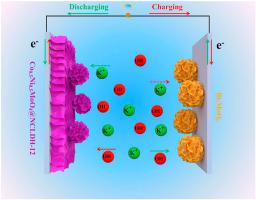Materials Today Energy ( IF 9.3 ) Pub Date : 2020-09-28 , DOI: 10.1016/j.mtener.2020.100549 W. Kang , X. Kong , J. Li , P. Wang , Y. Sun , X. Zhang , H. Yang , B. Lin

|
Aqueous rechargeable batteries represent one promising candidate for new energy storage and conversion systems because of their good safety, low cost, high energy density based on Faradic reactions, and high power density originated from the high ionic conductivity of aqueous electrolyte. Herein, a novel aqueous rechargeable nickel-bismuth battery was developed with highly porous Bi2MoO6 microspheres as anode active materials and delicately designed binder-free Co0.5Ni0.5MoO4@NiCo-layered double hydroxide heterostructure nanoarrays as the cathode for the first time. The Bi2MoO6 anode active materials exhibit outstanding electrochemical performances (such as high capacity of 163.2 mAh/g at 1 A/g and superior rate capability of 79.6% at 15 A/g) owing to their porous structure. To obtain the improved cathode, substitution of Co for Ni species of CoXNi1-XMoO4 as ‘core’ materials and growing time of NiCo-layered double hydroxide onto the ‘core’ materials were optimized systematically. The optimal cathode (Co0.5Ni0.5MoO4@NCLDH-12) affords appreciably enhanced electrochemical performances with the high capacity of 386.7 mAh/g at 1 A/g and good rate capability of 64.9% at 15 A/g owing to its advantages in composition and architecture. Desirably, the nickel-bismuth battery can deliver the acceptable maximum energy density of 41.5 W h/kg and power density of 3896.2 W/kg, respectively. The excellent electrochemical performances can be put down to the elaborate architectures of electrodes and synergistic effect between active materials. This current research would enrich the chemistry systems of present aqueous rechargeable batteries and also pave the way to effectively construct promising electrode active materials for aqueous rechargeable nickel-bismuth batteries.
中文翻译:

基于多孔Bi 2 MoO 6微球和Co x Ni 1-x MoO 4 @NiCo层状双氢氧化物异质结构纳米阵列的新型水性可充电镍铋电池
水性可充电电池由于其良好的安全性,低成本,基于法拉第反应的高能量密度以及源自水性电解质的高离子电导率的高功率密度,因此是新能源存储和转换系统的一种有前途的候选者。在此,开发了一种新型的水性可充电镍铋电池,该电池以高孔隙度的Bi 2 MoO 6微球为阳极活性材料,并精心设计了无粘合剂的Co 0.5 Ni 0.5 MoO 4 @NiCo层状双氢氧化物异质结构纳米阵列作为第一个阴极。时间。Bi 2 MoO 6负极活性材料由于具有多孔结构,因此具有出色的电化学性能(例如,在1 A / g时具有163.2 mAh / g的高容量,在15 A / g时具有79.6%的优异倍率性能)。为了获得改进的阴极,系统地优化了用Co替代Co X Ni 1-X MoO 4中的Ni类作为“核”材料,以及NiCo层状双氢氧化物在“核”材料上的生长时间。最佳阴极(Co 0.5 Ni 0.5 MoO 4@ NCLDH-12)由于其在成分和结构上的优势,提供了明显增强的电化学性能,在1 A / g时的容量为386.7 mAh / g,在15 A / g时的速率率为64.9%。理想地,镍-铋电池可以分别提供可接受的最大能量密度为41.5 W h / kg和功率密度为3896.2 W / kg。优异的电化学性能可以归因于复杂的电极结构和活性材料之间的协同作用。这项当前的研究将丰富当前的水性可充电电池的化学系统,并为有效地构建用于水性可充电镍铋电池的有希望的电极活性材料铺平道路。


























 京公网安备 11010802027423号
京公网安备 11010802027423号